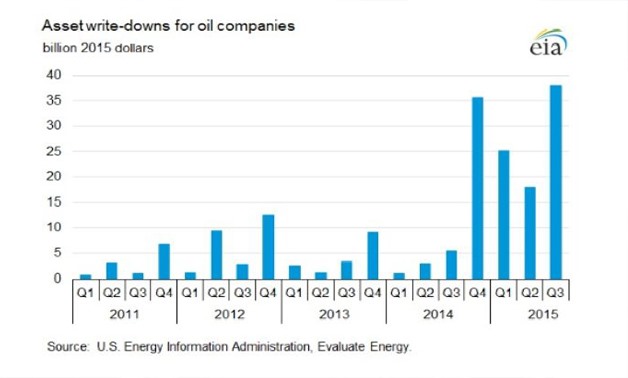
Asset write downs for oil companies 2015- CC
CAIRO - 28 June 2017: Oil prices sharply pulled back as the market reacted to preliminary data that suggested US crude stockpiles unexpectedly rose last week, CNBC reported.
US West Texas Intermediate crude eased back to $43.70, after ending Tuesday's session at $44.24, up 86 cents, or 2 percent.
International benchmark Brent crude futures were up 33 cents to $46.16 by 4:47 p.m. ET (2047 GMT).
The American Petroleum Institute reported a surprise 851,000 barrel increase in US crude inventories in the week through June 23.
Crude stocks were expected to fall by 3.25 million barrels, according to a survey of analysts by S&P Global Platts.
The API figures capture a smaller portion of total US storage than official government data and frequently diverge significantly from Energy Department figures, which are out Wednesday at 10:30 a.m. ET (1430 GMT).
US stockpiles at the Cushing, Oklahoma delivery hub for the WTI contract fell by 678,000 barrels, according to the API data. The read on Cushing is considered the most accurate in the API figures.
Oil prices surged 2 percent earlier on Tuesday as traders covered bets that oil prices will fall further and the market anticipated a drop in US crude inventories.
Technical analysts have identified support levels between $40.40 and $40.70, according to Tom Kloza, global head of energy analysis at Oil Price Information Service
"I don't want to call [Tuesday's price rise] a dead cat bounce," he said, referring to a brief recovery from a sharp decline. "But it's a nominal bounce. It's certainly nothing that proves that the bear market is over."
"I think it's the notion that the next $7 will be a move up as opposed to a move down," he added.
Analysts and traders told CNBC oil's plunge to the low $40 range has made traders less likely to take out new short positions, or bets that prices will fall further.
With consensus forming around the idea the bottom is likely somewhere in the upper $30 range, there is too little reward in opening new short positions, analysts said. A bounce higher on a supply disruption or geopolitical event could make a bet on a further drop a costly one.
In the week through June 20, the ratio of long positions to short positions in WTI among money managers on the New York Mercantile Exchange further narrowed from recent highs, a contrarian signal that the market is approaching a bottom
Comments
Leave a Comment